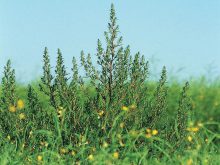The crop chemical arms of DuPont and Syngenta are working together on a new class of herbicide chemistry they’ve jointly patented and taken to the “pre-development” stage.
DuPont Crop Protection and Syngenta announced Monday they’ve published a joint patent, titled “Substituted cyclic amides and their use as herbicides,” and expect to launch herbicides based on the patent in 2023.
“Success in this field will bring much needed new technology to farmers in the increasingly challenging area of weed management, including resistance,” Jonathan Parr, president of Syngenta’s crop protection arm, said in a release.
Read Also

India slaps 30 per cent import duty on yellow peas
India has imposed a 30 per cent duty on yellow pea imports with a bill of lading date on or after Nov. 1, 2025.
Of course, many herbicides are already commercially available for selective and broad-spectrum use, the companies said in their patent, “but the need continues for new compounds that are more effective, less costly, less toxic, environmentally safer or have different sites of action.”
The companies said their tests show compounds of the chemistry in question are “highly active” as pre-emergent and/or post-emergent herbicides and/or plant growth regulants, including many as broad-spectrum products for “complete control of all vegetation.”
Other compounds in the class, they said, are “useful for the selective control of grass and broadleaf weeds within a crop/weed mixture.”
Compounds in the class “may show tolerance to important agronomic crops,” the companies said, listing wheat, barley, oats, rapeseed, soybeans, corn, alfalfa, potatoes, tomatoes, vegetables, tree fruit, turf species, rice and “plantation” crops such as coffee, tea, cocoa and sugarcane, among others.
Specifically, the companies said in their patent, compounds of their new chemistry may show “surprising selective activity” against weeds common to rice crops, and “particular activities” against weeds in cereal crops, including wild oats and green foxtail, among others.
The companies also said a “particularly useful embodiment” of the new class will be in the development of herbicide compounds that can be used for selective in-crop weed control.
The herbicide chemistry can be used in this case by applying an antidote chemical to the crop at the same time, or by applying “antidotally effective amounts of safeners” to the crop before seeding, as a seed treatment.
Compounds of their new chemistry can also be mixed with “one or more other biologically active compounds or agents” including other herbicides as well as fungicides, insecticides, plant growth regulators and pheromones, among others. — AGCanada.com Network












